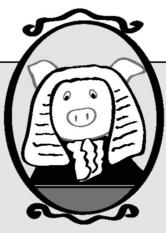Politically Incorrect Guide To The Constitution (Politically Incorrect Guides) (29 page)
Read Politically Incorrect Guide To The Constitution (Politically Incorrect Guides) Online
Authors: Kevin R. C. Gutzman

Professor Bernard Schwartz speaks for most academic analysts of the proFDR Supreme Court when he says, in his book A History of the Supreme
Court, that the Court was simply "adjust[ing] the intent of the Framers to
contemporary needs." Thus, the pre-1937 Court's defense of the Constitution against the New Deal's massive expansion of federal power had
been, he says, "government by judiciary."
The Court continued to "adjust [one might say "ignore"] the intent of
the Framers." In 1941's United States v. Darby, it upheld federal mini mum wage legislation and overruled Hammer v. Dagenhart-the Child
Labor Case-so that poor families could no longer send their children to
work (except on family farms and in other family businesses).
In the 1942 case of Wickard v. Filburn, the Court produced a decision
so absurd as to be beyond parody. The case concerned enforcement of the
Agricultural Adjustment Act of 1938, which restricted the acreage on
which individual farmers could grow wheat. (Congress's stated goal was
to prop up Depression farm incomes, not to starve the legions of already
malnourished unemployed.) Roscoe Filburn, a wheat farmer in Ohio,
exceeded his allotment by growing wheat
to feed his family and his livestock. Filburn insisted that as his extra wheat was
not intended for interstate commerce,
Congress had no power to regulate it and
could not punish him for growing his own
food.
The Supreme Court conceded that Filburn's actions had not been "commerce,"
but nevertheless ruled that this was immaterial. According to the Court, Congress could regulate any activity that
"exerts a substantial economic effect on interstate commerce." "That [his]
own contribution to the demand for wheat may be trivial by itself is not
enough to remove him from the scope of federal regulation where, as
here, his contribution, taken together with that of many others similarly
situated, is far from trivial."
As professor Richard Epstein of the University of Chicago has noted,
by this measure the Commerce Clause gives Congress power to regulate
"just about anything." It also makes an absolutely dead letter of the Tenth
Amendment's reservation of undelegated powers to the states.

A Book You're Not
Supposed to Read
Government byludiciary: The Transformation of the Fourteenth Amendment by Raoul
Berger (second edition); Indianapolis: Liberty
Fund, 1997.
rather than interpreted
In Darby, the Court had offered up the sage claim that the Tenth Amendment "states but a truism that all is retained which has not been surrendered. There is nothing in the history of its adoption to suggest that it was
more than declaratory of the relationship between the national and state
governments as it had been established by the Constitution before the
Amendment."
As we have seen, the second sentence of this statement is true:
Edmund Randolph and other leading Federalists had vowed during the
ratification process that Congress would have only the powers it was
"expressly delegated," and the Tenth Amendment was only a restatement
of this principle already said to be implicit in the unamended Constitution. But that does not answer the objection that nowhere in the Constitution was Congress "expressly delegated" power to undertake the
extensive regulation of the economy-and, ultimately, of virtually every
other conceivable area of human endeavor-that the Supreme Court
allowed it to undertake after 1937. In other words, just because the Tenth
Amendment principle that virtually all power was reserved to the states
was understood before the Tenth Amendment was adopted does not
mean that the Tenth Amendment principle should never be applied!
A typical law school casebook, Donald Kommers, John Finn, and Gary
Jacobsohn's American Constitutional Law (second edition), follows its
excerpt from Wickard with the Tenth Amendment snippet from Darby,
and then asks, "Do you agree?" Of course, without more, an aspiring
lawyer can only weigh his political preferences; he cannot understand
that what was under way in Darby, Wickard, and contemporary cases was
a radically anti-constitutional transformation of the American federal
system-a virtual judicial coup d'etat.
If the Court was going to get out of the business of limiting state and
congressional initiative in the economic realm, what was it going to do
instead? A hint came in the most famous (though, as we shall see, not the
most revealing) footnote in the Court's history: U.S. v. Carolene Products
Co. (1938), footnote four. There, in the midst of a majority opinion
announcing that regulatory statutes would be presumed to be rational
(thus blunting the old rational-basis test for statutes' constitutionality),
the Court said that it was not necessary to
consider whether such a "presumption of
constitutionality" was appropriate in cases
involving application of Bill of Rights provisions against the states, cases related to the
political process, or cases involving "discrete and insular minorities."
In other words, having left the business of
enforcing authentically constitutional limitations on Congress's economic and social
powers and having overturned its own
unconstitutional (although largely socially
desirable) limitations on state economic regulation, the Court had found a new role for itself: enforcer of Bill of Rights
provisions and protector of "discrete and insular" (meaning, at first,
mainly racial) minorities.
Ironically, the Court's new use of the Bill of Rights was akin to the old
laissez-faire majority's use of the Due Process Clause of the Fourteenth
Amendment. In the old cases that the Court disavowed beginning in
1937, it had created a doctrine-"freedom of contract"-found nowhere
in the Constitution, and it had used that doctrine as justification for invalidating a plethora of state policies the justices disliked.

The Layman's View
Sounds Like the
Court's View
"The layman's constitutional view is that
what he likes is constitutional and that
which he doesn't like is unconstitutional."
Justice Hugo L. Black
In the new Bill of Rights cases, the Court would invent a concept-
"incorporation"-unrelated to the Constitution's language and history
and would use that concept as a justification for invalidating myriad
types of state social policy.
So what is "incorporation"? "Incorporation" was (and is) the Court's
subterfuge to get around the plain historical fact that the Bill of Rights
was ratified to limit the powers of the federal government alone. This fact
had been affirmed by the unanimous Marshall Court decision in Barron
v. Baltimore (1833).
According to proponents of the Incorporation Doctrine, Barron was
good law until 1868. Then the Fourteenth Amendment was (supposedly)
ratified. When it said that no state could deprive anyone of life, liberty,
or property without due process of law, it made the Bill of Rights (or at
least the Court's favorite Bill of Rights provisions) enforceable by federal
courts against the states.
To paraphrase Justice Robert H. Jackson, the justices are not supreme
because they are infallible; they are infallible because they are supreme.
When a majority of them set their minds to enforcement of an Incorporation Doctrine, they can have their way.
You might think that if a majority of justices set out to enforce a doctrine, like the Incorporation Doctrine, that is plainly at variance with historical truth, they would be hooted down in legal academia and the legal
profession generally, and that eventually their mistake would be corrected through the appointment process. Three factors combined to allow
the Incorporation Doctrine bacillus to work its way through the legal system:
1. The nature of contemporary legal education
2. The long-lasting ascendancy of the New Deal congressional
(and intellectual) majority
3. The appeal to the intellectual class of the model of government that the Incorporation Doctrine decisions represent
Legal education today is much different from what it was in John Marshall's day, or even early in the twentieth century. When Thomas Jefferson and Edmund Randolph, John Marshall and Patrick Henry studied
law, they did so by reading treatises in what was called the science of law.
Common-law study was in its nature historical and theoretical, and familiarity with the history of England was essential to it.
Now, however, American law students are almost universally subjected to the case method. Their texts are collections of judicial opinions,
or in a few cases of statutes, with absolutely no historical context. One
prominent legal academic at a leading law school responded to my
friend's query why he had not assigned readings from The Federalist to
his introductory class in constitutional law by saying that The Federalist
was "irrelevant" to the subject of "constitutional law"-and he was right.
In short, if the judges make a particular false assertion about the Constitution in numerous cases, students reading those opinions have no way
of recognizing that assertion's falsity. They are provided no tools for analyzing judges' claims-only with scads of the opinions incorporating
those claims. This is one reason why legal training should not be confused with an education.
When the pro-New Deal position began its long (one might argue permanent) ascendancy on the Supreme Court, academia and the legal profession generally remained stocked with opponents. Non-liberals were in
a decided minority among academics, then as now, but adherents to the
old view on federalism remained numerous. Over time, however, Democrats' reign over Congress-nearly uninterrupted from 1933 to 1994meant that the federal courts came to be stocked with, stacked with, New
Dealers-in fact if not in name. Even today's "conservatives" like justice Antonin Scalia give little thought to overturning the Incorporation Doctrine, for example, or the three 1937 precedents marking the Court's capitulation to the new political reality.
The centralized model of government that the New Deal embodied
appeals to the socialist leanings of most intellectuals. Something in the
typical intellectual finds the idea of the philosopher king-or the philosopher court-appealing. Who needs all those dirty elections, all that
demeaning electioneering, anyway, when you can get the right result by
following the Rule of Five: he who has five votes, rules? (The term "Rule
of Five" comes from the late justice William Brennan, the outstanding
example of an American judge who promiscuously used his power to
substitute his preferences for the preferences of the Constitution's ratifiers and the electorate.)
With the thin reed of the Fourteenth Amendment's Due Process Clause
as its support, the Court undertook to redefine American church-state relations, race relations, federal-state relations, the rights of accused criminals, the freedoms of speech and the press, and, in the end, sexual
mores-even normality. The jumping-off point was a determined (and
ongoing) attempt to secularize American society, thus bringing more of it
under the Court's own purview and that of the federal government.
Portrait of a Justice

